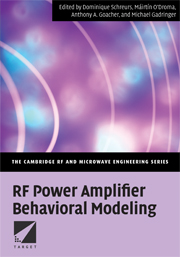Book contents
- Frontmatter
- Contents
- Notation
- Abbreviations
- Preface
- 1 Overview of power amplifier modelling
- 2 Properties of behavioural models
- 3 Memoryless nonlinear models
- 4 Nonlinear models with linear memory
- 5 Nonlinear models with nonlinear memory
- 6 Validation and comparison of PA models
- 7 Aspects of system simulation
- Appendix A Recent wireless standards
- Appendix B Authors and contributors
- Index
Appendix A - Recent wireless standards
Published online by Cambridge University Press: 06 January 2010
- Frontmatter
- Contents
- Notation
- Abbreviations
- Preface
- 1 Overview of power amplifier modelling
- 2 Properties of behavioural models
- 3 Memoryless nonlinear models
- 4 Nonlinear models with linear memory
- 5 Nonlinear models with nonlinear memory
- 6 Validation and comparison of PA models
- 7 Aspects of system simulation
- Appendix A Recent wireless standards
- Appendix B Authors and contributors
- Index
Summary
Introduction
Since the early 1980s, the range and variety of wireless communication air interfaces has seen immense growth. This has been driven, and is being driven further, by the need for ever greater information throughput. This requires greater bandwidths, higher output transmitter powers and the more efficient use of handheld battery energy resources and all at ever higher frequencies, although some lower frequencies have been freed up from the traditional broadcast communication services and are becoming available.
One complex modulation scheme that has grown in importance over the last decade is orthogonal frequency-division multiplexing (OFDM). It is a scheme which increases bandwidth efficiency and data capacity by splitting broadband channels into multiple narrowband channels, each using a different frequency, which can then carry different parts of a message simultaneously at bit per hertz capacities that are dynamically adaptable to the wireless channel quality.
This trend is set to continue for the foreseeable future and will result in a wide range of complex wireless communications systems sharing a common physical space. This has major implications for the development of communicationsimulation tools.
In this appendix some advanced wireless interface standards are summarised with a view to highlighting the broad range of signal formats and figures of merit that have to be considered when developing system simulators. These are especially relevant when simulators with embedded nonlinear elements such as nonlinear PA behavioural models are being developed.
The three interfaces selected provide wireless coverage from long range to very short range and have been developed by the Institute of Electrical and Electronics Engineers Inc. through the IEEE 802.11, 802.15 and 802.16 Work Groups.
- Type
- Chapter
- Information
- RF Power Amplifier Behavioral Modeling , pp. 253 - 259Publisher: Cambridge University PressPrint publication year: 2008

